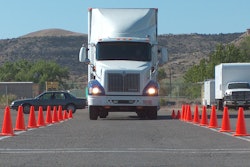For decades, we’ve struggled both with the whole driver-training issue and at what age someone is ready to accept the immense responsibility that comes with working as a driver.
Though I haven’t researched in depth the history of such proposals, I do know the latest Congressional bills to allow 18-20-year-olds, with certain restrictions, to drive interstate don’t spring from exactly brand-new ideas. Congress has introduced bills since 2015 that, if passed, would have changed the current interstate rules, and the idea certainly has been talked about for a much longer time than that.
Is a public debate the best way to address the questions surrounding whether an 18-year-old person should be offered the option to drive a commercial vehicle across state lines?
I was able to talk earlier in the year to Vicki Kimball, now former program instructor for the Tri-County Technical Center located in Dexter, Maine. This was an eye-opening opportunity to learn about how successful this decades-old educational program has been. This public vocational school’s two-year truck driver training program graduates on average 20 students per year. It could well be an educational model that many other states and schools learn from.
 Click through the image or follow this link to explore more about the center’s training work via its central website.
Click through the image or follow this link to explore more about the center’s training work via its central website.Part of the formula for success there lies in the CDL rules within the state of Maine. These 16-18-year-old students have the option to obtain an intrastate CDL after first having a valid license to drive a smaller vehicle. That opens up immediate employment opportunities locally in-state.

Vicki Kimball’s passion for these opportunities was easy to recognize as she described what is a time-tested model for developing competent young drivers. Vicki’s personal experience as a team driver with her husband for 5 years, too, has provided a strong foundation with the requisite knowledge needed.
When I listened to her, I sensed a bit of the drill sergeant’s approach to managing these students’ futures. Strong passion, I might call it, with no small amount of compassion. She emphasized the way new students quickly develop a more mature attitude through training, really grabbing hold of the notion of personal responsibility for their education and actions.
Peer pressure and peer teaching play a large role. Within just a few weeks in training these students are behind the wheel of the school’s conventional tractor-trailers, learning together — no short cuts. The course begins with classroom work and the pre-trip inspection, instilling I dare say possibly a fuller understanding of the inner workings of the mechanics of this equipment than that held by many older truck drivers. So many have entered this industry through what we know today as conventional schools, generally less time-intensive private training programs where as little as a few days to a few weeks can suffice to pass the CDL exam and basic driving test.
The model employed at Vicki and company’s school seems a good alternative, yet another big question mark remains. At what point should should trucking and insurance companies step up and embrace the essential responsibilities and risks involved in employing young drivers? Upon graduation from the tech center program, it’s possible for those Maine students to be employed in any number of local companies or family operations. But driver liability insurance coverage and cost present challenges for employers. When it comes to young drivers, insurance issues may remain the biggest barrier to employment for the future driver under 21.
This long-running truck driver training program has been a working laboratory that our industry leadership and government regulators could learn from. The length of time and money invested in adjusting or creating new legislation and/or regulations has been an expensive exercise, too often more of a quick band aid to try to stop the bleeding rather than strengthen the body.
My experience teaching has been with now thousands of high-school-age drivers, focused on operating safely around big trucks. In these classes, I always ask, “Is anyone interested in becoming a truck driver?” In most classes, there are a few students who respond or approach me at the end of class to ask questions. They typically have some knowledge of what’s required through a family member, and are hopeful and excited, anticipating the future.
In short, we have 18-20-year-old people who are quite capable and have a passion to become truck drivers. There is a window of opportunity here with these young people, and by delaying opportunities, we might all be missing out.













